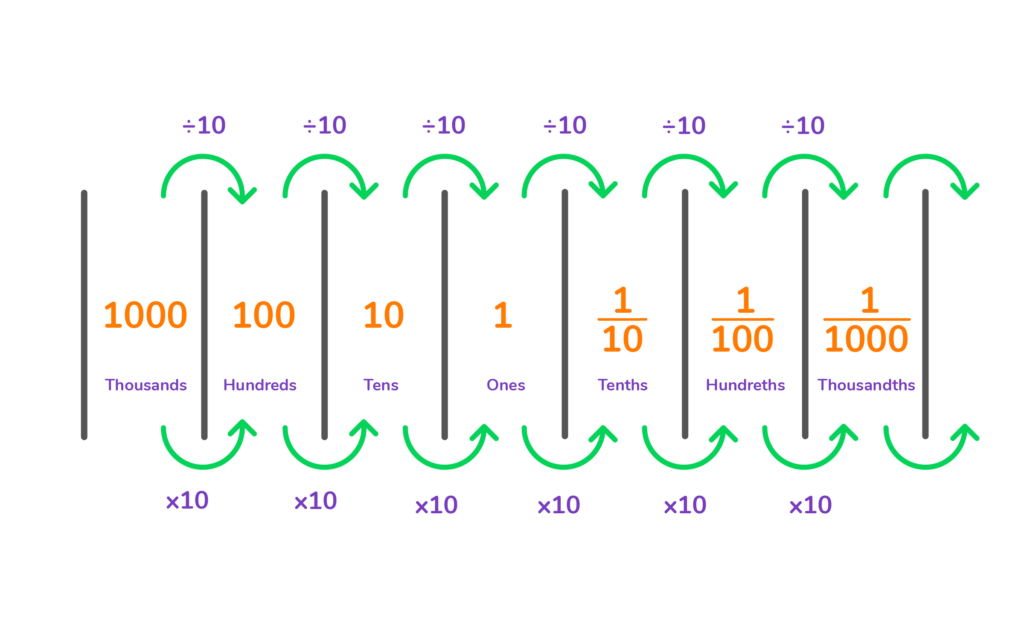

Discover the ins and outs of decimal place values – what they’re named, how they work and how to apply them to real problems

Author
Tess Loucka
Published
November 7, 2023


Discover the ins and outs of decimal place values – what they’re named, how they work and how to apply them to real problems

Author
Tess Loucka
Published
Nov 1, 2023


Discover the ins and outs of decimal place values – what they’re named, how they work and how to apply them to real problems

Author
Tess Loucka
Published
Nov 7, 2023


Key takeaways
When you’re buying something in town or measuring something with a ruler, you’ve probably noticed that you don’t always get whole numbers. For example, a chocolate bar might cost you £1.98, or a shelf in your room might be 15.25 inches long!
But how do you work with numbers like this?
In this article, we’ll go over decimal place values, decimal comparison, rounding decimals and the decimal place value chart.
Decimals are numbers made up of a whole number followed by a fractional number. These two numbers are separated by a dot called a decimal point.
For example, 13.5 is a decimal number because of the decimal point in the middle. The 13 is the whole number and the 5 is a fractional part.
Numbers that come after decimal points should be thought of as fractions. The position a number falls in relation to the decimal point is called its decimal place value.
Let’s take a look at a decimal places chart to better understand each decimal place.
Unlock unlimited maths questions
Put your learning into practice with fun exercises + games that are proven to boost ability!
Decimal place values have different names and values according to how close or far away they are from the decimal point. The decimal places are all powers of 10. This is visualised on the decimal chart.
Place value chart with decimals:

Take a look at the decimals chart above.
Decimal numbers get smaller as they move farther away from the decimal point, and larger as they move closer. Whole numbers are the opposite.
Let’s compare the tens place and the tenths place. When a whole number reaches the tens place, it means there are tens of something. When a decimal number reaches the tenths place, it means there is a tenth of something or a fraction of a whole.
The tenths place is one decimal place after the decimal point and is the largest value decimal place. Numbers in this place are called tenths because when turned into fractions, they are put over a 10.
Ex. 13.5 = 13 5/10 or 13 ½ when simplified
The hundredths place comes second after the decimal point. When decimal numbers reach this place, it means they will be written over 100 in fraction form.
Ex. 12.25 = 12 25/100 or 12 ¼
The thousandths place comes third after the decimal point. When turned into a fraction, these numbers will be written over 1,000.
Ex. 3.825 = 3 825/1,000 or 3 33/44
We already mentioned that negative numbers appear on thermometers to show us that the temperature is ‘below zero’, but that’s not the only real-life example of negative numbers.
Negative numbers are all around us! When we make purchases, the money or credit due is a negative number. Negative numbers also appear on elevation maps to indicate places that are ‘below sea level’.
Negative numbers can be used as penalties in games, quizzes, and tests. When you get an answer wrong, you may get -5 points, meaning 5 points are being taken away from your total score.
In sports, too, negative numbers can be used to denote the scores of teams. One great example is golf. The golfer with the lowest score, which represents the least amount of strokes, wins!
As you can see, there are many real-world applications of negative numbers. They may not be as common as positive numbers, but they’re just as important.
Now, let’s go over the rules for working with negative numbers.

Pi is a rare number that has 31.4 trillion decimal place values and counting!
When doing math with pi, mathematicians definitely don’t use 31.4 trillion decimal places. They round pi down to a more manageable number. At NASA, pi is rounded down to 15 digits: 3.14159265358979.
Let’s try rounding to the one decimal place.
What is 12.57 rounded to the nearest tenths place?
We’re rounding to the tenths place, so look at the hundredths place. In this case, that’s 7.
Next, determine whether this number is 5 or more, or 4 or less. Numbers 5 or more are rounded up. Numbers 4 or less are kept the same. In this case, round up since 7 falls under the category of 5 or more.
So, 12.57 rounded to the nearest tenth is 12.6.
Now let’s try to round to three decimal places. What is 2.4983 rounded to the nearest thousandths place?
The number that comes after the thousandths place is 3. Since 3 falls under the category of 4 or less, we will be keeping the number in the thousandths place the same.
So, 2.4983 rounded to the nearest thousandth is 2.498!
Click on the boxes below to see the answers!
Answer: 5 34/100.
Since the number 5.34 ends in the hundredths decimal place, the number after the decimal point can be written over 100 in fraction form.
Answer: 8.72
To round to the second decimal place, look at the number that comes after it in the thousandths place, 3. Since 3 is smaller than 5, you keep the hundredths place the same. So, 8.723 rounded to the second decimal place is 8.72.
Answer: 1.6
To compare the size of decimal numbers, start by comparing the whole numbers and work your way to the right. The number 1.54 has a 5 in the tenths place while 1.6 has a 6 in the tenths place. Six is larger than 5, so 1.6 is the larger number.
Decimal place value is the value of numbers according to how far away they are from a decimal point. Place values after a decimal point represent fractions of a whole number.
Place value in decimals starts with the tenths place and grows by powers of 10 as you move to the right. The second place value is the hundredths place and the third is the thousandths place.
No, negative numbers are not whole numbers. Whole numbers are only positive round numbers, including 0.
The hundredths place in a decimal is the second decimal place value after the decimal point.

Lesson credits

Tess Loucka
Tess Loucka discovered her passion for writing while at school and has not stopped writing since. Combined with her love of numbers, she became a maths and English tutor. Since graduating, her goal has been to use her writing to spread knowledge and the joy of learning to readers of all ages.

Tess Loucka
Tess Loucka discovered her passion for writing while at school and has not stopped writing since. Combined with her love of numbers, she became a maths and English tutor. Since graduating, her goal has been to use her writing to spread knowledge and the joy of learning to readers of all ages.
How to multiply decimals
Master multiplying decimals with our step-by-step guide and practice questions
Converting decimals to fractions
Discover how to convert decimals to fractions and view some examples
Book a chat with our team
If you’d like to use Doodle’s browser version, please visit this page on a desktop.
To log in to Doodle on this device, you can do so through our apps. You can find out how to download them here: